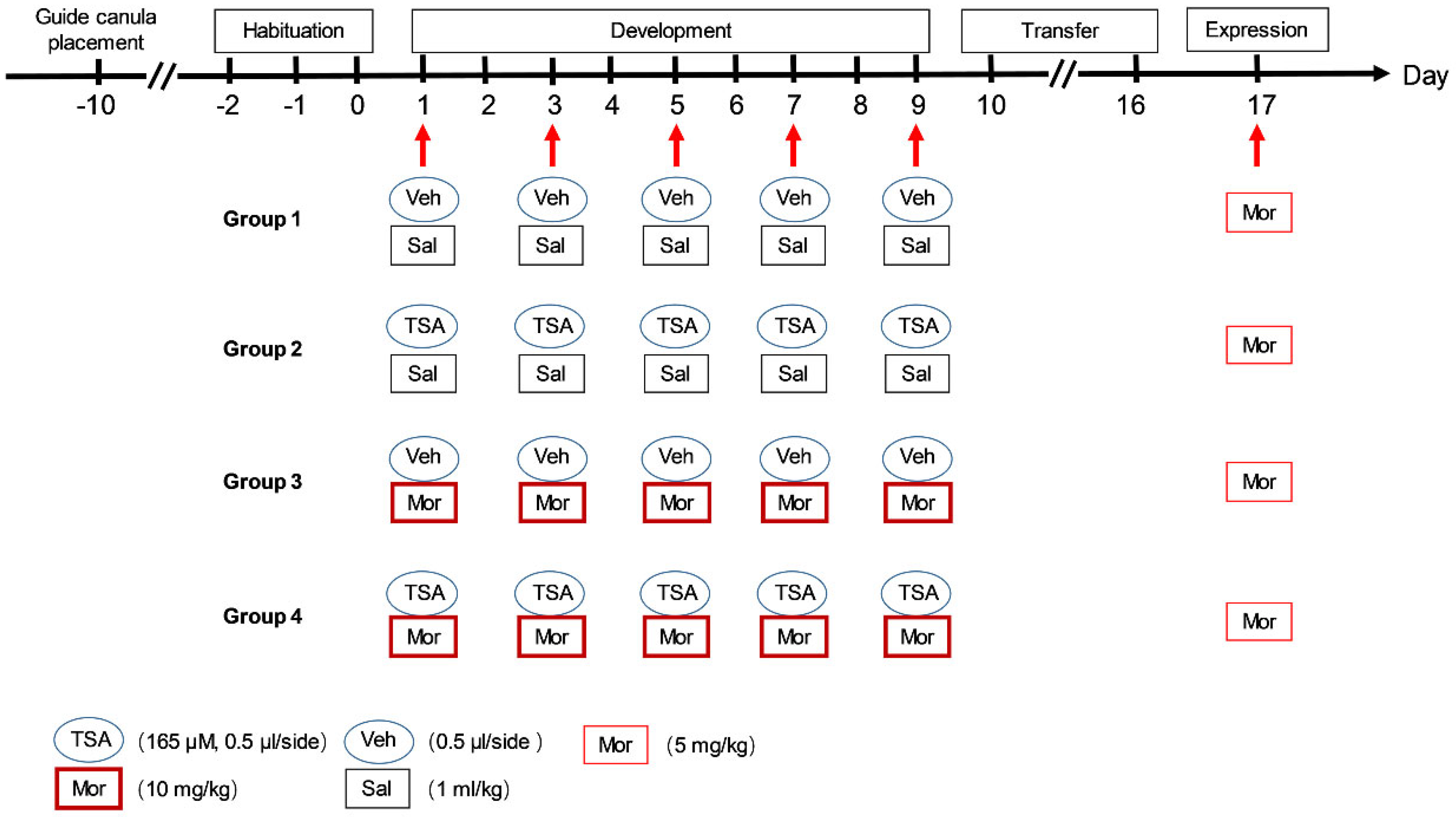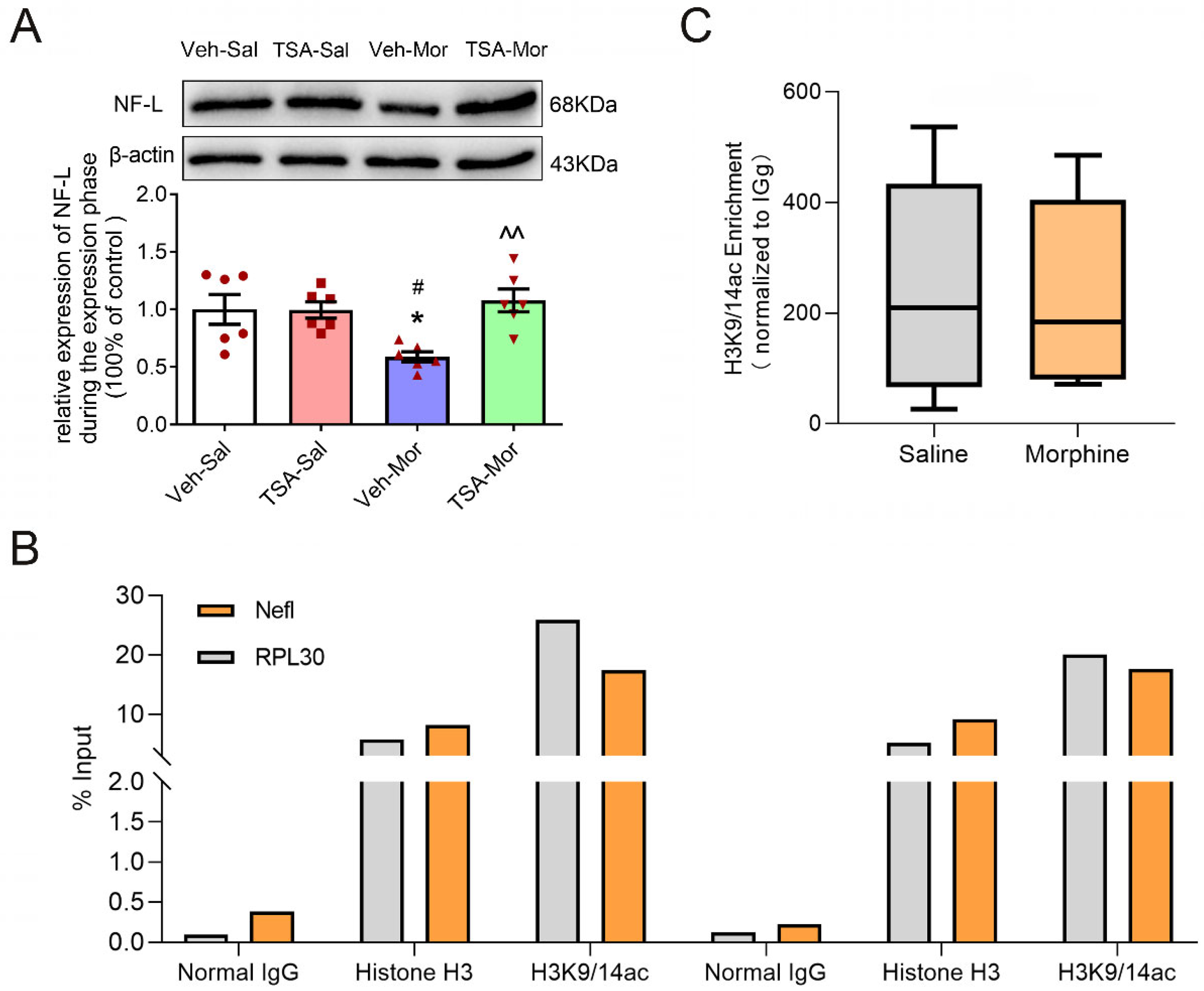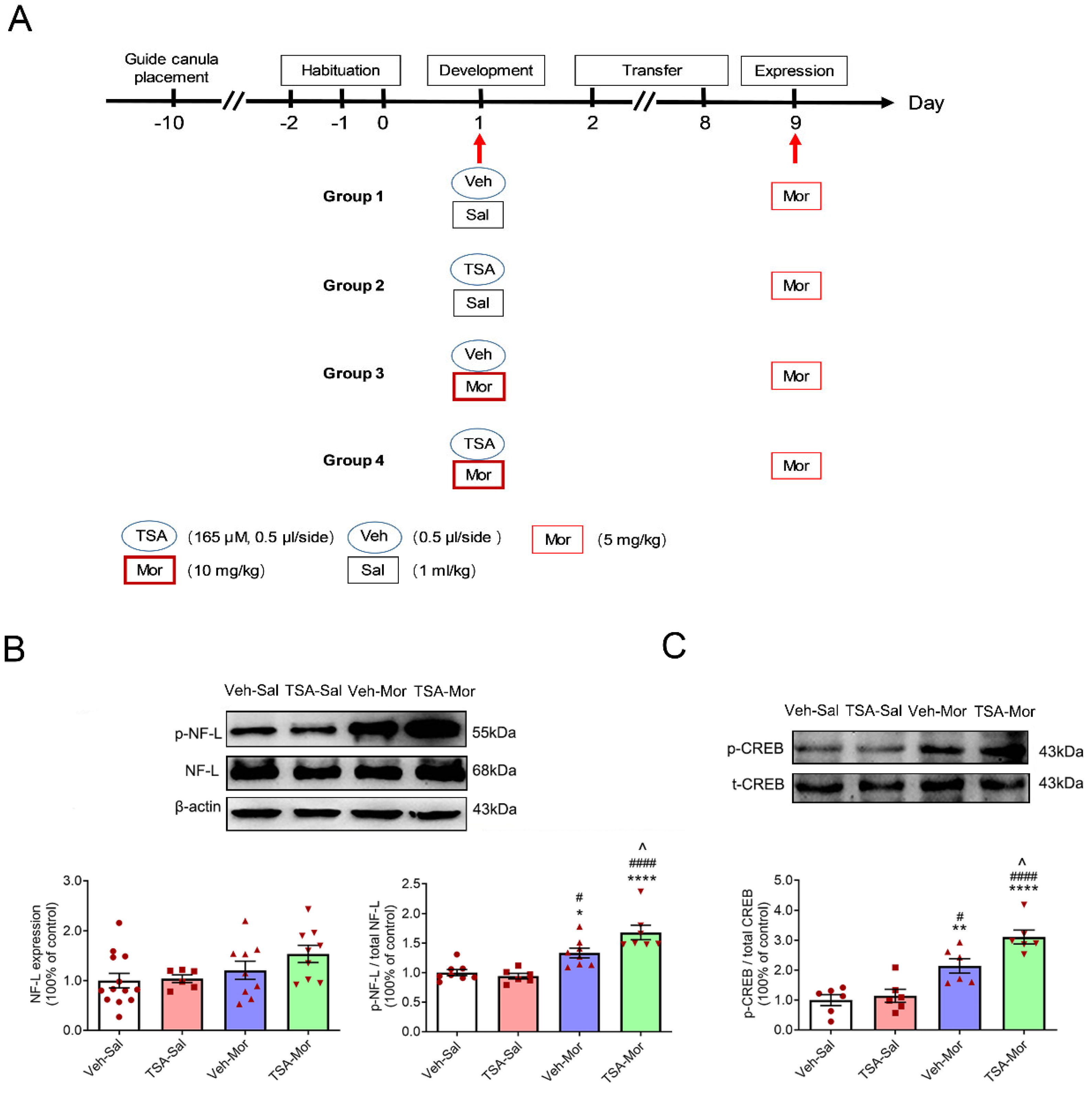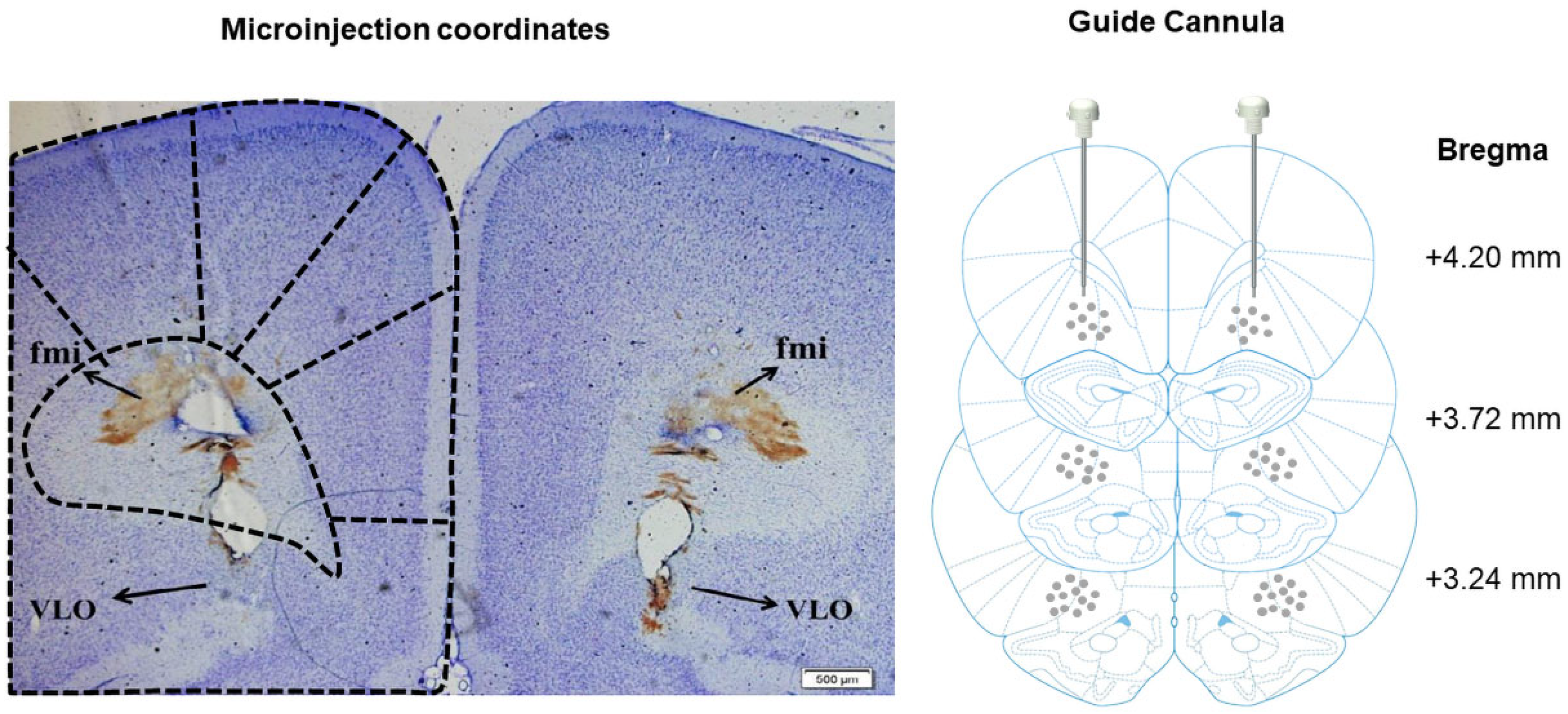Phosphorylation of Neurofilament Light Chain in the VLO Is Correlated with Morphine-Induced Behavioral Sensitization in Rats
Abstract
1. Introduction
2. Results
2.1. Microinjection of TSA into the VLO Suppresses the Locomotor Activity during Expression Phase, but Does Not Affect the Locomotor Activity during Development Phase
2.2. Chronic Morphine-Induced Behavioral Sensitization Inhibits the Expression of Total NF-L in the VLO, While TSA Microinjection Reverses This Inhibitory Effect
2.3. The Down-Regulation of NF-L Expression after Chronic Morphine-Induced Behavioral Sensitization Is Not Due to the Direct Acetylation of H3K9/14 at NF-L Gene
2.4. Chronic Morphine-Induced Behavioral Sensitization Promotes the Phosphorylation of ERK, CREB and NF-L in the VLO, While TSA Microinjection Reverses These Effects
2.5. Acute Morphine-Induced Behavioral Sensitization Promotes the Phosphorylation of CREB and NF-L in the VLO, While TSA Microinjection Reinforces These Effects
3. Discussion
3.1. Microinjection of TSA into the VLO Significantly Decreased Rats’ Locomotion in the Expression Phase of Morphine-Induced Chronic Behavioral Sensitization
3.2. The Inhibitory Effect of TSA on Chronic Morphine-Induced Behavioral Sensitization Might Be Correlated with p-ERK/p-CREB/p-NF-L Signaling Pathway, Rather Than Having a Direct Influence on NF-L Expression
3.3. The TSA Has Opposing Effects on Acute versus Chronic Morphine-Induced Behavioral Sensitization
4. Materials and Methods
4.1. Animals and Drugs
4.2. Surgery for Bilateral Intracerebral Guide Cannula Placement
4.3. Intracerebral Microinjection
4.4. Behavioral Sensitization
4.5. Western Blotting
4.6. Chromatin Immunoprecipitation (ChIP)-qPCR Assay
4.7. Histology Examination
4.8. Data Analysis
Author Contributions
Funding
Institutional Review Board Statement
Informed Consent Statement
Data Availability Statement
Acknowledgments
Conflicts of Interest
Abbreviations
References
- Baumbach, J.L.; McCormick, C.M. Nicotine sensitization (part 1): Estradiol or tamoxifen is required during the induction phase and not the expression phase to enable locomotor sensitization to nicotine in female rats. Psychopharmacology 2021, 238, 355–370. [Google Scholar] [CrossRef] [PubMed]
- Kozlova, A.; Butler, R.R.; Zhang, S.; Ujas, T.; Zhang, H.; Steidl, S.; Sanders, A.R.; Pang, Z.P.; Vezina, P.; Duan, J. Sex-specific nicotine sensitization and imprinting of self-administration in rats inform GWAS findings on human addiction phenotypes. Neuropsychopharmacology 2021, 46, 1746–1756. [Google Scholar] [CrossRef]
- Hardung, S.; Epple, R.; Jäckel, Z.; Eriksson, D.; Uran, C.; Senn, V.; Gibor, L.; Yizhar, O.; Diester, I. A Functional Gradient in the Rodent Prefrontal Cortex Supports Behavioral Inhibition. Curr. Biol. 2017, 27, 549–555. [Google Scholar] [CrossRef]
- Wei, L.; Zhu, Y.-M.; Zhang, Y.-X.; Liang, F.; Barry, D.M.; Gao, H.-Y.; Li, T.; Huo, F.-Q.; Yan, C.-X. Microinjection of histone deacetylase inhibitor into the ventrolateral orbital cortex potentiates morphine induced behavioral sensitization. Brain Res. 2016, 1646, 418–425. [Google Scholar] [CrossRef]
- Wei, L.; Liu, B.; Yao, Z.; Yuan, T.; Wang, C.; Zhang, R.; Wang, Q.; Zhao, B. Sirtuin 1 inhibitor EX527 suppresses morphine-induced behavioral sensitization. Neurosci. Lett. 2021, 744, 135599. [Google Scholar] [CrossRef] [PubMed]
- Fan, L.; Chen, H.; Liu, Y.; Hou, H.; Hu, Q. ERK signaling is required for nicotine-induced conditional place preference by regulating neuroplasticity genes expression in male mice. Pharmacol. Biochem. Behav. 2023, 222, 173510. [Google Scholar] [CrossRef]
- Yuan, A.; Sershen, H.; Veeranna; Basavarajappa, B.S.; Kumar, A.; Hashim, A.; Berg, M.; Lee, J.H.; Sato, Y.; Rao, M.V.; et al. Neurofilament subunits are integral components of synapses and modulate neurotransmission and behavior in vivo. Mol. Psychiatry 2015, 20, 986–994. [Google Scholar] [CrossRef] [PubMed]
- Ashton, N.J.; Janelidze, S.; Al Khleifat, A.; Leuzy, A.; van der Ende, E.L.; Karikari, T.K.; Benedet, A.L.; Pascoal, T.A.; Lleó, A.; Parnetti, L.; et al. A multicentre validation study of the diagnostic value of plasma neurofilament light. Nat. Commun. 2021, 12, 3400. [Google Scholar] [CrossRef]
- Yuan, A.; Nixon, R.A. Neurofilament Proteins as Biomarkers to Monitor Neurological Diseases and the Efficacy of Therapies. Front. Neurosci. 2021, 15, 689938. [Google Scholar] [CrossRef]
- García-Sevilla, J.A.; Ventayol, P.; Busquets, X.; La Harpe, R.; Walzer, C.; Guimón, J. Marked decrease of immunolabelled 68 kDa neurofilament (NF-L) proteins in brains of opiate addicts. Neuroreport 1997, 8, 1561–1565. [Google Scholar] [CrossRef]
- Zhang, Y.X.; Akumuo, R.C.; España, R.A.; Yan, C.X.; Gao, W.J.; Li, Y.C. The histone demethylase KDM6B in the medial prefrontal cortex epigenetically regulates cocaine reward memory. Neuropharmacology 2018, 141, 113–125. [Google Scholar] [CrossRef]
- Cadet, J.L.; Jayanthi, S. Epigenetics of addiction. Neurochem. Int. 2021, 147, 105069. [Google Scholar] [CrossRef]
- Wang, W.-S.; Kang, S.; Liu, W.-T.; Li, M.; Liu, Y.; Yu, C.; Chen, J.; Chi, Z.-Q.; He, L.; Liu, J.-G. Extinction of aversive memories associated with morphine withdrawal requires ERK-mediated epigenetic regulation of brain-derived neurotrophic factor transcription in the rat ventromedial prefrontal cortex. J. Neurosci. 2012, 32, 13763–13775. [Google Scholar] [CrossRef] [PubMed]
- Sagarkar, S.; Balasubramanian, N.; Mishra, S.; Choudhary, A.G.; Kokare, D.M.; Sakharkar, A.J. Repeated mild traumatic brain injury causes persistent changes in histone deacetylase function in hippocampus: Implications in learning and memory deficits in rats. Brain Res. 2019, 1711, 183–192. [Google Scholar] [CrossRef]
- Wang, Y.; Lai, J.; Cui, H.; Zhu, Y.; Zhao, B.; Wang, W.; Wei, S. Inhibition of histone deacetylase in the basolateral amygdala facilitates morphine context-associated memory formation in rats. J. Mol. Neurosci. 2015, 55, 269–278. [Google Scholar] [CrossRef] [PubMed]
- Yin, F.; Zhang, J.; Lu, Y.; Zhang, Y.; Liu, J.; Deji, C.; Qiao, X.; Gao, K.; Xu, M.; Lai, J.; et al. Modafinil rescues repeated morphine-induced synaptic and behavioural impairments via activation of D1R-ERK-CREB pathway in medial prefrontal cortex. Addict. Biol. 2022, 27, e13103. [Google Scholar] [CrossRef]
- Zhu, H.; Zhuang, D.; Lou, Z.; Lai, M.; Fu, D.; Hong, Q.; Liu, H.; Zhou, W. Akt and its phosphorylation in nucleus accumbens mediate heroin-seeking behavior induced by cues in rats. Addict. Biol. 2021, 26, e13013. [Google Scholar] [CrossRef]
- Pogun, S.; Yararbas, G.; Nesil, T.; Kanit, L. Sex differences in nicotine preference. J. Neurosci. Res. 2017, 95, 148–162. [Google Scholar] [CrossRef]
- Wei, L.; Zhu, Y.-M.; Zhang, Y.-X.; Liang, F.; Li, T.; Gao, H.-Y.; Huo, F.-Q.; Yan, C.-X. The α1 adrenoceptors in ventrolateral orbital cortex contribute to the expression of morphine-induced behavioral sensitization in rats. Neurosci. Lett. 2016, 610, 30–35. [Google Scholar] [CrossRef]
- Kalivas, P.W.; Duffy, P. Sensitization to repeated morphine injection in the rat: Possible involvement of A10 dopamine neurons. J. Pharmacol. Exp. Ther. 1987, 241, 204–212. [Google Scholar] [PubMed]
- Kuribara, H. Effects of interdose interval on ambulatory sensitization to methamphetamine, cocaine and morphine in mice. Eur. J. Pharmacol. 1996, 316, 1–5. [Google Scholar] [CrossRef]
- Ojanen, S.; Koistinen, M.; Bäckström, P.; Kankaanpää, A.; Tuomainen, P.; Hyytiä, P.; Kiianmaa, K. Differential behavioural sensitization to intermittent morphine treatment in alcohol-preferring AA and alcohol-avoiding ANA rats: Role of mesolimbic dopamine. Eur. J. Neurosci. 2003, 17, 1655–1663. [Google Scholar] [CrossRef]
- Jean-Richard-Dit-Bressel, P.; McNally, G.P. Lateral, not medial, prefrontal cortex contributes to punishment and aversive instrumental learning. Learn. Mem. 2016, 23, 607–617. [Google Scholar] [CrossRef]
- Zovkic, I.B.; Guzman-Karlsson, M.C.; Sweatt, J.D. Epigenetic regulation of memory formation and maintenance. Learn. Mem. 2013, 20, 61–74. [Google Scholar] [CrossRef]
- Mews, P.; Egervari, G.; Nativio, R.; Sidoli, S.; Donahue, G.; Lombroso, S.I.; Alexander, D.C.; Riesche, S.L.; Heller, E.A.; Nestler, E.J.; et al. Alcohol metabolism contributes to brain histone acetylation. Nature 2019, 574, 717–721. [Google Scholar] [CrossRef]
- Subbanna, S.; Joshi, V.; Basavarajappa, B.S. Activity-dependent Signaling and Epigenetic Abnormalities in Mice Exposed to Postnatal Ethanol. Neuroscience 2018, 392, 230–240. [Google Scholar] [CrossRef]
- García-Sevilla, J.A.; Ferrer-Alcón, M.; Martín, M.; Kieffer, B.L.; Maldonado, R. Neurofilament proteins and cAMP pathway in brains of mu-, delta- or kappa-opioid receptor gene knock-out mice: Effects of chronic morphine administration. Neuropharmacology 2004, 46, 519–530. [Google Scholar] [CrossRef]
- Thomas, G.M.; Huganir, R.L. MAPK cascade signalling and synaptic plasticity. Nat. Rev. Neurosci. 2004, 5, 173–183. [Google Scholar] [CrossRef]
- Yang, X.; Wen, Y.; Zhang, Y.; Gao, F.; Yang, J.; Yang, Z.; Yan, C. Dynamic Changes of Cytoskeleton-Related Proteins Within Reward-Related Brain Regions in Morphine-Associated Memory. Front. Neurosci. 2020, 14, 626348. [Google Scholar] [CrossRef] [PubMed]
- Valjent, E.; Pagès, C.; Hervé, D.; Girault, J.-A.; Caboche, J. Addictive and non-addictive drugs induce distinct and specific patterns of ERK activation in mouse brain. Eur. J. Neurosci. 2004, 19, 1826–1836. [Google Scholar] [CrossRef]
- Breen, K.C.; Robinson, P.A.; Wion, D.; Anderton, B.H. Partial sequence of the rat heavy neurofilament polypeptide (NF-H) Identification of putative phosphorylation sites. FEBS Lett. 1988, 241, 213–218. [Google Scholar] [CrossRef] [PubMed]
- Chwang, W.B.; Arthur, J.S.; Schumacher, A.; Sweatt, J.D. The nuclear kinase mitogen- and stress-activated protein kinase 1 regulates hippocampal chromatin remodeling in memory formation. J. Neurosci. 2007, 27, 12732–12742. [Google Scholar] [CrossRef] [PubMed]
- Zhang, Y.X.; Yang, M.; Liang, F.; Li, S.Q.; Yang, J.S.; Huo, F.Q.; Yan, C.X. The pronociceptive role of 5-HT6 receptors in ventrolateral orbital cortex in a rat formalin test model. Neurochem. Int. 2019, 131, 104562. [Google Scholar] [CrossRef] [PubMed]
- Zhang, Y.; Yang, J.; Yang, X.; Wu, Y.; Liu, J.; Wang, Y.; Huo, F.; Yan, C. The 5-HT6 Receptors in the Ventrolateral Orbital Cortex Attenuate Allodynia in a Rodent Model of Neuropathic Pain. Front. Neurosci. 2020, 14, 884. [Google Scholar] [CrossRef] [PubMed]
- Hsu, F.-S.; Wu, J.-T.; Lin, J.-Y.; Yang, S.-P.; Kuo, K.-L.; Lin, W.-C.; Shi, C.-S.; Chow, P.-M.; Liao, S.-M.; Pan, C.-I.; et al. Histone Deacetylase Inhibitor, Trichostatin A, Synergistically Enhances Paclitaxel-Induced Cytotoxicity in Urothelial Carcinoma Cells by Suppressing the ERK Pathway. Int. J. Mol. Sci. 2019, 20, 1162. [Google Scholar] [CrossRef]
- Lin, W.-C.; Hsu, F.-S.; Kuo, K.-L.; Liu, S.-H.; Shun, C.-T.; Shi, C.-S.; Chang, H.-C.; Tsai, Y.-C.; Lin, M.-C.; Wu, J.-T.; et al. Trichostatin A, a histone deacetylase inhibitor, induces synergistic cytotoxicity with chemotherapy via suppression of Raf/MEK/ERK pathway in urothelial carcinoma. J. Mol. Med. 2018, 96, 1307–1318. [Google Scholar] [CrossRef]
- Lu, J.-C.; Chang, Y.-T.; Wang, C.-T.; Lin, Y.-C.; Lin, C.-K.; Wu, Z.-S. Trichostatin A modulates thiazolidinedione-mediated suppression of tumor necrosis factor α-induced lipolysis in 3T3-L1 adipocytes. PLoS ONE 2013, 8, e71517. [Google Scholar] [CrossRef]
- Oride, A.; Kanasaki, H.; Mijiddorj, T.; Sukhbaatar, U.; Miyazaki, K. Trichostatin A specifically stimulates gonadotropin FSHβ gene expression in gonadotroph LβT2 cells. Endocr. J. 2014, 61, 335–342. [Google Scholar] [CrossRef]
- Yao, J.; Qian, C.-J.; Ye, B.; Zhang, X.; Liang, Y. ERK inhibition enhances TSA-induced gastric cancer cell apoptosis via NF-κB-dependent and Notch-independent mechanism. Life Sci. 2012, 91, 186–193. [Google Scholar] [CrossRef]
- Arany, I.; Herbert, J.; Herbert, Z.; Safirstein, R.L. Restoration of CREB function ameliorates cisplatin cytotoxicity in renal tubular cells. Am. J. Physiol.-Renal Physiol. 2008, 294, F577–F581. [Google Scholar] [CrossRef]
- Sheng, J.; Lv, Z.; Wang, L.; Zhou, Y.; Hui, B. Histone H3 phosphoacetylation is critical for heroin-induced place preference. Neuroreport 2011, 22, 575–580. [Google Scholar] [CrossRef]
- Paxinos, G.; Watson, C. The Rat in Stereotaxic Coordinates; Academic Press: San Diego, CA, USA, 1986. [Google Scholar]
- Zhao, Y.; Xing, B.; Dang, Y.H.; Qu, C.L.; Zhu, F.; Yan, C.X. Microinjection of valproic acid into the ventrolateral orbital cortex enhances stress-related memory formation. PLoS ONE 2013, 8, e52698. [Google Scholar] [CrossRef]
- Aida-Yasuoka, K.; Yoshioka, W.; Kawaguchi, T.; Ohsako, S.; Tohyama, C. A mouse strain less responsive to dioxin-induced prostaglandin E2 synthesis is resistant to the onset of neonatal hydronephrosis. Toxicol. Sci. 2014, 141, 465–474. [Google Scholar] [CrossRef]
- Hayashi, H.; Higashi, T.; Yokoyama, N.; Kaida, T.; Sakamoto, K.; Fukushima, Y.; Ishimoto, T.; Kuroki, H.; Nitta, H.; Hashimoto, D.; et al. An Imbalance in TAZ and YAP Expression in Hepatocellular Carcinoma Confers Cancer Stem Cell-like Behaviors Contributing to Disease Progression. Cancer Res. 2015, 75, 4985–4997. [Google Scholar] [CrossRef]
- Singh, R.; De Aguiar, R.B.; Naik, S.; Mani, S.; Ostadsharif, K.; Wencker, D.; Sotoudeh, M.; Malekzadeh, R.; Sherwin, R.S.; Mani, A. LRP6 enhances glucose metabolism by promoting TCF7L2-dependent insulin receptor expression and IGF receptor stabilization in humans. Cell Metab. 2013, 17, 197–209. [Google Scholar] [CrossRef]
- Salvucci, O.; Ohnuki, H.; Maric, D.; Hou, X.; Li, X.; Yoon, S.O.; Segarra, M.; Eberhart, C.G.; Acker-Palmer, A.; Tosato, G. EphrinB2 controls vessel pruning through STAT1-JNK3 signalling. Nat. Commun. 2015, 6, 6576. [Google Scholar] [CrossRef]
- Farrell, J.J.; Sherva, R.M.; Chen, Z.Y.; Luo, H.Y.; Chu, B.F.; Ha, S.Y.; Li, C.K.; Lee, A.C.; Li, R.C.; Li, C.K.; et al. A 3-bp deletion in the HBS1L-MYB intergenic region on chromosome 6q23 is associated with HbF expression. Blood 2011, 117, 4935–4945. [Google Scholar] [CrossRef]







Disclaimer/Publisher’s Note: The statements, opinions and data contained in all publications are solely those of the individual author(s) and contributor(s) and not of MDPI and/or the editor(s). MDPI and/or the editor(s) disclaim responsibility for any injury to people or property resulting from any ideas, methods, instructions or products referred to in the content. |
© 2023 by the authors. Licensee MDPI, Basel, Switzerland. This article is an open access article distributed under the terms and conditions of the Creative Commons Attribution (CC BY) license (https://creativecommons.org/licenses/by/4.0/).
Share and Cite
Zhang, Y.-X.; Zhu, Y.-M.; Yang, X.-X.; Gao, F.-F.; Chen, J.; Yu, D.-Y.; Gao, J.-Q.; Chen, Z.-N.; Yang, J.-S.; Yan, C.-X.; et al. Phosphorylation of Neurofilament Light Chain in the VLO Is Correlated with Morphine-Induced Behavioral Sensitization in Rats. Int. J. Mol. Sci. 2023, 24, 7709. https://doi.org/10.3390/ijms24097709
Zhang Y-X, Zhu Y-M, Yang X-X, Gao F-F, Chen J, Yu D-Y, Gao J-Q, Chen Z-N, Yang J-S, Yan C-X, et al. Phosphorylation of Neurofilament Light Chain in the VLO Is Correlated with Morphine-Induced Behavioral Sensitization in Rats. International Journal of Molecular Sciences. 2023; 24(9):7709. https://doi.org/10.3390/ijms24097709
Chicago/Turabian StyleZhang, Yu-Xiang, Yuan-Mei Zhu, Xi-Xi Yang, Fei-Fei Gao, Jie Chen, Dong-Yu Yu, Jing-Qi Gao, Zhen-Nan Chen, Jing-Si Yang, Chun-Xia Yan, and et al. 2023. "Phosphorylation of Neurofilament Light Chain in the VLO Is Correlated with Morphine-Induced Behavioral Sensitization in Rats" International Journal of Molecular Sciences 24, no. 9: 7709. https://doi.org/10.3390/ijms24097709
APA StyleZhang, Y.-X., Zhu, Y.-M., Yang, X.-X., Gao, F.-F., Chen, J., Yu, D.-Y., Gao, J.-Q., Chen, Z.-N., Yang, J.-S., Yan, C.-X., & Huo, F.-Q. (2023). Phosphorylation of Neurofilament Light Chain in the VLO Is Correlated with Morphine-Induced Behavioral Sensitization in Rats. International Journal of Molecular Sciences, 24(9), 7709. https://doi.org/10.3390/ijms24097709




